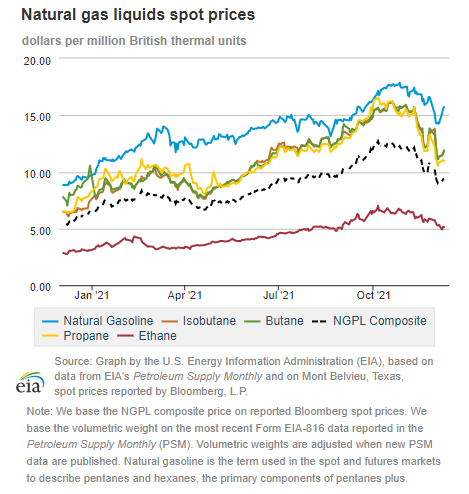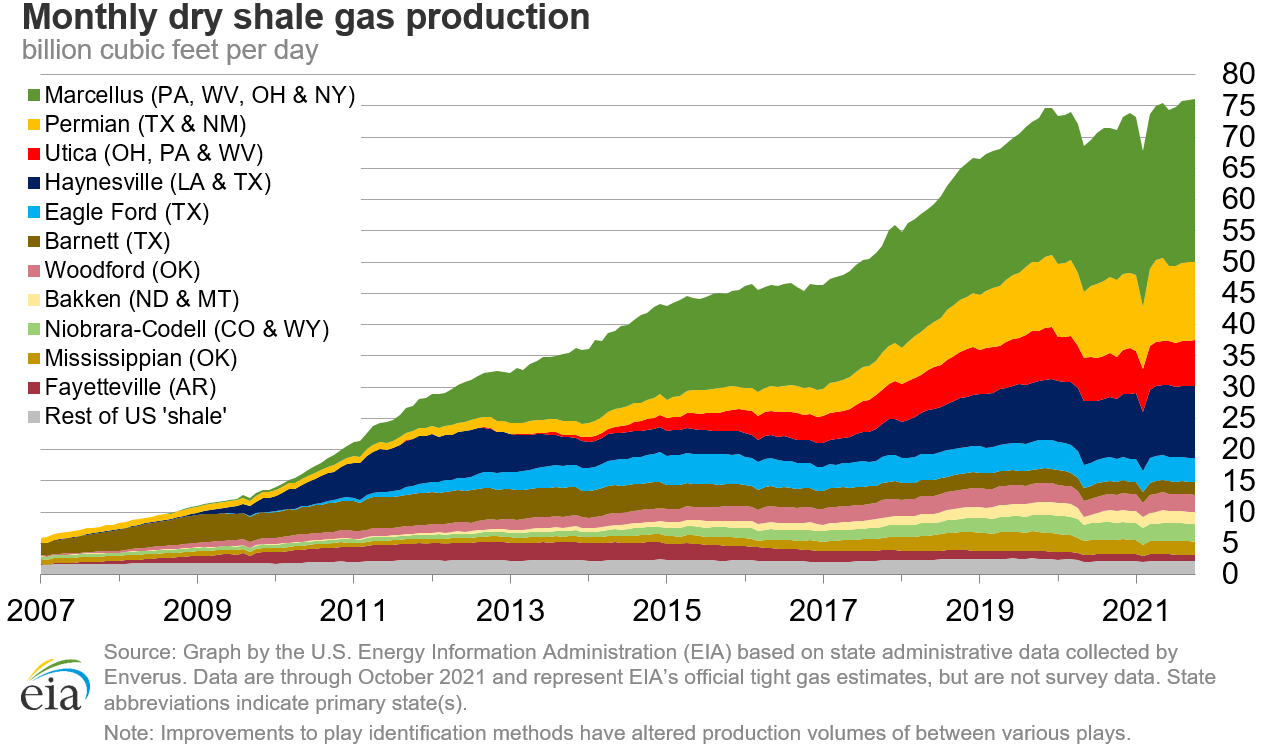In the News:
EIA forecasts that U.S. natural gas production will increase in 2022
In the December 2021 Short-Term Energy Outlook (STEO), we forecast that U.S. dry natural gas production will increase from 95.1 billion cubic feet per day (Bcf/d) in October 2021 to 97.5 Bcf/d by December 2022, an increase of 2.4 Bcf/d (2.5%). If realized, the December 2022 forecast production level will exceed the previous record of 97.2 Bcf/d, which was set in November 2019. The November 2019 record was set before COVID-19 was declared a pandemic, and before the COVID-19-associated declines in demand resulted in production declines to a low of 87.3 Bcf/d in May 2020. Dry natural gas production has generally risen since October 2020. Natural gas production remained above 92.0 Bcf/d in 2021, except in February, when a winter storm substantially affected oil and natural gas production in Texas.
The forecast for natural gas production is influenced by expectations for natural gas production from newly drilled gas-directed wells, natural gas production from existing wells, and the amount of associated natural gas resulting from oil production. The number of natural gas-directed rigs—rigs drilling primarily in natural gas-bearing formations—decreased throughout 2019 and into 2020. In August 2020, the rig count was at its lowest monthly average since 1987 (the earliest year of available data). Since August 2020, the natural gas-directed rig count has generally increased, averaging 102 rigs in November 2021, but remains about 40% lower than the average monthly count in 2019.
In both the Haynesville region and the Appalachian Basin, according to our Drilling Productivity Report, we expect dry natural gas production will set new highs this December as a result of both increased drilling activity and output per well. Associated natural gas production also increased because producers have been completing wells from their inventories of drilled but uncompleted (DUC) wells, which peaked in June 2020. Increases in both the number of natural gas-directed rigs and in associated natural gas production are expected to result in growing dry natural gas production in our December STEO forecast.
Overview:
(For the week ending Wednesday, December 8, 2021)
- Natural gas spot price movements were mixed this report week (Wednesday, December 1 to Wednesday, December 8). The Henry Hub spot price fell from $4.23 per million British thermal units (MMBtu) last Wednesday to $3.79/MMBtu yesterday.
- International natural gas prices remain near record highs this report week. Bloomberg Finance, L.P. reports that swap prices for liquefied natural gas (LNG) cargos in East Asia for the rest of December fell $1.41/MMBtu to a weekly average of $35.06/MMBtu, the second-highest weekly average since January 2020 but lower than last week’s average of $36.47/MMBtu. At the Title Transfer Facility (TTF) in the Netherlands, the most liquid natural gas spot market in Europe, the day-ahead price rose for the fifth week in a row to a weekly average of $31.18/MMBtu (also the second-highest weekly average on record), a $0.51/MMBtu increase from last week’s average of $30.67/MMBtu. In the same week last year (week ending December 9, 2020), prices in East Asia and at TTF were $7.57/MMBtu and $5.10/MMBtu, respectively.
- The price of the January 2022 NYMEX contract decreased 44.3 cents, from $4.258/MMBtu last Wednesday to $3.815/MMBtu yesterday. The price of the 12-month strip averaging January 2022 through December 2022 futures contracts declined 22.3 cents to $3.721/MMBtu. The forward curve continues to flatten. Futures contracts for the remainder of winter heating season delivery (January–March) declined 40.4 cents this report week to an average of $3.749/MMBtu. Contracts for summer delivery also declined, by 16.9 cents to $3.641/MMBtu, reducing the winter premium to 10.8 cents/MMBtu from 34.4 cents/MMBtu last week.
- The net withdrawals from working natural gas storage totaled 59 billion cubic feet (Bcf) for the week ending December 3. Working natural gas stocks totaled 3,505 Bcf, which is 9% lower than the year-ago level and 3% lower than the five-year (2016–2020) average for this week.
- The natural gas plant liquids composite price at Mont Belvieu, Texas, fell by 43 cents/MMBtu, averaging $9.20/MMBtu for the week ending December 8. Ethane prices fell 6%, while natural gas prices on the Houston Ship Channel fell 15%, widening the premium between ethane and natural gas by 30 cents/MMBtu, or 26%. Propane prices fell again this week, by 5%, following a mild start to the winter heating season and a counter-seasonal propane inventory build last week. Propane inventories rose 0.6 million barrels last week, the largest inventory build for this time of year in the past five years, compared with a five-year average 1.2 million barrel draw for the same week. The National Oceanic and Atmospheric Administration (NOAA) forecasts a high probability of above-average temperatures through mid-December across most of the Midwest and Northeast regions, which will result in reduced propane heating demand for this time of year. Prices of normal butane and isobutane, which are used in motor gasoline production and blending, fell 7% and 9%, respectively, as a result of declining exports and lower motor gasoline prices. Natural gasoline prices rose 3% following a 3% increase in Brent crude oil prices for the week ending December 8.
- According to Baker Hughes, for the week ending Tuesday, November 30, the natural gas rig count was unchanged at 102, a level it has held for the past four weeks. The number of oil-directed rigs was also flat this week at 467. Within the basins, the Permian Basin in New Mexico gained five rigs, the Permian Basin in Texas dropped by two rigs, the Monterey Basin dropped by two, and the Anadarko dropped by one for a net change of zero. The total rig count stands at 569.
Prices/Supply/Demand:
Prices along the Gulf Coast decline in response to lower heating demand expectations. This report week (Wednesday, December 1 to Wednesday, December 8), the Henry Hub spot price fell 44 cents from $4.23/MMBtu last Wednesday to $3.79/MMBtu yesterday. The Henry Hub spot price dropped to a weekly low of $3.63/MMBtu on Monday and then increased slightly through Wednesday in response to a near-term rise in demand that resulted from below-normal temperatures stretching across much of the Midwest, south to the Gulf Coast, and east to the Mid-Atlantic region. This rise in demand is unlikely to persist. Weather modeling based on NOAA’s Global Forecast System (GFS) suggests a significant warming trend is developing across many of the Lower 48 states that lie east of the Rockies through all of next week.
Feed gas volumes on the Gulf Coast exceeded 11.0 Bcf/d for the second consecutive week, reflecting rising LNG production at Cheniere’s Sabine Pass LNG export terminal, where the recently completed Train 6 produced its first cargo. Commissioning activities at Venture Global’s Calcasieu Pass LNG export terminal are also beginning to contribute to growing feed gas volume. TransCameron Pipeline, which serves the Calcasieu Pass terminal, reported that volumes on the pipeline have averaged approximately 28 million cubic feet per day (MMcf/d) this report week, almost 6 MMcf/d above last report week’s average, and set a new daily high of 51 MMcf/d of natural gas delivered to the terminal last Thursday.
Midwest prices fall, then rise, in response to lower-than-normal temperatures across the region late in the report week. At the Chicago Citygate, the price decreased 37 cents from $3.94/MMBtu last Wednesday to $3.57/MMBtu yesterday. Chicago Citygate prices, similar to prices at the Henry Hub, fell to a weekly low of $3.48/MMBtu on Monday before rising again on Tuesday and Wednesday in response to below-normal temperatures. Temperatures in the Chicago Area started the report week averaging 52°F last Thursday (17°F above normal) and dropped to a weekly low of 20°F (13°F below normal) on Tuesday. The winter storm currently stretching from the Western Rockies to the Great Lakes region is expected to last through Friday.
Prices in the West rise as a result of colder-than-normal weather, combined with impaired capacity on pipelines delivering natural gas into Southern California. Movements of natural gas on the Westcoast pipeline, which ships natural gas from the production region in northeastern British Columbia to Vancouver and the U.S-Canada border, remain impaired. Enbridge, the operator of the Westcoast system, reports capacity for delivery at the Huntington Station (the exit point at the British Columbia – Washington border) at a reduced level of 1,847 MMcf/d. The current level is 300 MMcf/d higher than on November 16, when one of two pipelines in the system was taken out of service due to heavy rain and landslides along the pipeline path, but almost 200 MMcf/d below the system’s reported capacity before the outage.
In addition to pipeline impairments, the weather in the region also turned cooler. Temperatures at the Seattle-Tacoma Airport averaged lower than 39°F over the weekend, more than 4°F below normal. The continuing impairment to natural gas deliveries into the Pacific Northwest, combined with below-normal temperatures across the region, resulted in rising natural gas prices in the region. The price at Sumas on the Canada-Washington border rose 98 cents from $3.85/MMBtu last Wednesday to $4.83/MMBtu yesterday. The price rise in the Pacific Northwest resulted in higher prices at Malin, Oregon, on the California border, the northern delivery point into the PG&E service territory. The price at Malin, Oregon, rose $1.05 from $3.91/MMBtu last Wednesday to $4.96/MMBtu yesterday.
Higher prices in the supply regions resulted in natural gas prices rising in Northern California. The price at PG&E Citygate in Northern California rose 54 cents, up from $4.69/MMBtu last Wednesday to $5.23/MMBtu yesterday. Temperatures in the Sacramento area averaged 49°F this week, resulting in 109 heating degree days (HDDs—a measure of heating demand), compared with 85 HDDs last week. IHS Markit estimates weekly average consumption in California rose 0.9 Bcf/d week over week, primarily as a result of rising heating demand in the residential and commercial sector, which rose by more than 0.5 Bcf/d.
The price at SoCal Citygate in Southern California increased $2.69 from a weekly low of $4.62/MMBtu last Wednesday to a weekly high of $7.31/MMBtu yesterday. Prices rose as a result of rising natural gas demand in the region and continuing reduced flows on the El Paso Natural Gas transmission system that moves natural gas from West Texas to Southern California (last week’s Prices/Supply/Demand section provides more details).
Prices in the Northeast rise at the end of the report week in response to a winter storm moving across the region. At the Algonquin Citygate, which serves Boston-area consumers, the price went up $3.69 from $4.93/MMBtu last Wednesday to $8.62/MMBtu yesterday. Prices at Algonquin Citygate rose as high as $12.14/MMBtu on Tuesday as a storm system bringing colder temperatures moved into New England Tuesday evening. Temperatures in the Boston Area fell from an average of 52°F on Monday (almost 14°F above normal), to 40°F on Tuesday, and then dropped below 33°F yesterday. In response to the drop in temperature, natural gas demand in the residential and commercial sector in New England increased more than 60%, rising from 1.5 Bcf on December 6 to 2.4 Bcf on December 8, according to data from IHS Markit. The storm system followed fluctuating temperatures (although warmer for this time of year) earlier in the report week, which resulted in 165 HDDs for the report week compared with NOAA's 30-year average of 185 HDDs for this period. Warmer temperatures are expected to return to the region by the weekend.
Pipeline issues have also contributed to rising prices at Algonquin Citygate this week. Tennessee Gas Pipeline (TGP) announced a force majeure at Station 261 in central Massachusetts as a result of repairs needed on one of the units. TGP estimated a reduction in flows of approximately 150 MMcf/d.
At the Transcontinental Pipeline Zone 6 trading point for New York City, the price decreased 31 cents, from $3.88/MMBtu last Wednesday to $3.57/MMBtu yesterday, after rising to a weekly high of $5.74/MMBtu on Tuesday. IHS Markit estimates natural gas consumption in the New York/New Jersey area fell by 10% from last week to an average of 6.5 Bcf/d this week as a result of declines in consumption in all end-use sectors.
Prices in the Appalachia production region fall, much like prices at the Henry Hub. The Tennessee (TGP) Zone 4 Marcellus spot price decreased 54 cents from $3.62/MMBtu last Wednesday to $3.08/MMBtu yesterday. The price at Eastern Gas South in southwest Pennsylvania fell 49 cents from $3.65/MMBtu last Wednesday to $3.16/MMBtu yesterday. Prices at both TGP Zone 4 and Eastern Gas South fell to weekly lows on Monday, at $3.00/MMBtu and $3.07/MMBtu, respectively, before increasing in response to lower temperatures in the Midwest and Northeast consuming regions.
Prices in the Permian production region in West Texas decline but not as much as prices on the Gulf Coast. The price at the Waha Hub in West Texas, which is located near Permian Basin production activities, fell 28 cents this report week from $3.75/MMBtu last Wednesday to $3.47/MMBtu yesterday. The Waha Hub traded 32 cents below the Henry Hub price yesterday, compared with last Wednesday, when it traded 48 cents below the Henry Hub price.
U.S. supply of natural gas decreases slightly across most sectors this report week. According to data from IHS Markit, the average total supply of natural gas fell by 1.1% (1.1 Bcf/d) compared with the previous report week. Compared with last week’s 96.1 Bcf/d, dry natural gas production decreased by 0.7% (0.7 Bcf/d) to 95.4 Bcf/d this week. Average net imports from Canada fell to 4.8 Bcf/d, which is 7.8% (0.4 Bcf/d) below last week’s 5.3 Bcf/d.
U.S. natural gas consumption remains relatively unchanged week over week. Total U.S. consumption of natural gas fell by 0.4% (0.3 Bcf/d) compared with the previous report week, according to data from IHS Markit. Consumption fell in all sectors except the power generation sector, which rose by 2.5% (0.7 Bcf/d) week over week. Industrial sector consumption decreased by 0.5% (0.1 Bcf/d) week over week. In the residential and commercial sectors, natural gas consumption declined by 2.6% (0.9 Bcf/d) as a result of above-normal daytime and nighttime temperatures across most of the United States during the past week, as reported by NOAA. Natural gas exports to Mexico fell by 1.6% (0.1 Bcf/d) this week to 5.3 Bcf/d. Natural gas deliveries to U.S. LNG export facilities (LNG pipeline receipts) were essentially flat this week at 11.9 Bcf/d, or 0.4% (0.01 Bcf/d) lower than last week.
U.S. LNG exports increased this week from last week. Twenty-six LNG vessels (seven from Sabine Pass, six from Freeport, five from Corpus Christi, five from Cameron, two from Cove Point, and one from Elba Island) with a combined LNG-carrying capacity of 95 Bcf departed the United States between December 2 and December 8, 2021, according to shipping data provided by Bloomberg Finance, L.P.
Storage:
The net withdrawals from storage totaled 59 Bcf for the week ending December 3, compared with the five-year (2016–2020) average net withdrawals of 55 Bcf and last year's net withdrawals of 78 Bcf during the same week. Working natural gas stocks totaled 3,505 Bcf, which is 90 Bcf lower than the five-year average and 356 Bcf lower than last year at this time.
According to The Desk survey of natural gas analysts, estimates of the weekly net change to working natural gas stocks ranged from net withdrawals of 42 Bcf to 72 Bcf, with a median estimate of 55 Bcf.
More storage data and analysis can be found on the Natural Gas Storage Dashboard and the Weekly Natural Gas Storage Report.
See also:
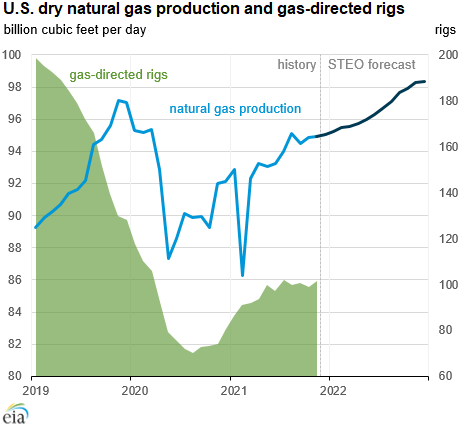 Source: U.S. Energy Information Administration, Short-Term Energy Outlook and Baker Hughes Company.
Source: U.S. Energy Information Administration, Short-Term Energy Outlook and Baker Hughes Company. Note: Natural gas directed rig counts are total monthly averages based on weeky estimates
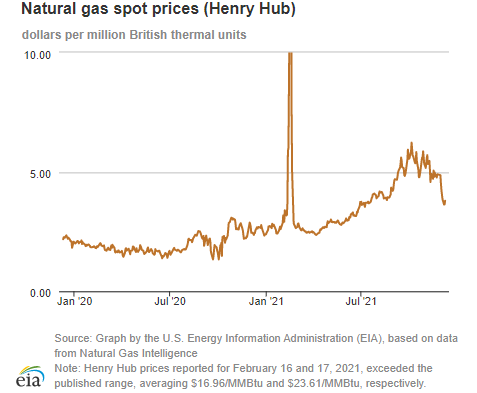
| Spot Prices ($/MMBtu) | Thu, 02-Dec |
Fri, 03-Dec |
Mon, 06-Dec |
Tue, 07-Dec |
Wed, 08-Dec |
|---|---|---|---|---|---|
| Henry Hub |
4.04 |
3.86 |
3.63 |
3.64 |
3.79 |
| New York |
4.03 |
3.70 |
3.94 |
5.74 |
3.57 |
| Chicago |
3.84 |
3.75 |
3.48 |
3.56 |
3.57 |
| Cal. Comp. Avg.* |
4.11 |
4.27 |
4.63 |
5.30 |
5.47 |
| Futures ($/MMBtu) | |||||
| January contract | 4.056 |
4.132 |
3.657 |
3.708 |
3.815 |
| February contract |
3.997 |
4.073 |
3.625 |
3.674 |
3.774 |
| *Avg. of NGI's reported prices for: Malin, PG&E Citygate, and Southern California Border Avg. | |||||
| Source: NGI's Daily Gas Price Index | |||||
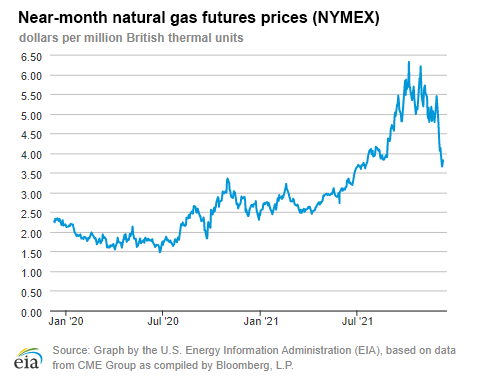
| U.S. natural gas supply - Gas Week: (12/2/21 - 12/8/21) | |||
|---|---|---|---|
Average daily values (billion cubic feet) |
|||
this week |
last week |
last year |
|
| Marketed production | 107.4 |
108.1 |
102.0 |
| Dry production | 95.4 |
96.1 |
90.5 |
| Net Canada imports | 4.8 |
5.3 |
5.8 |
| LNG pipeline deliveries | 0.1 |
0.1 |
0.1 |
| Total supply | 100.3 |
101.4 |
96.5 |
|
Source: Chart by the U.S. Energy Information Administration (EIA), based on data from IHS Markit | |||
| U.S. natural gas consumption - Gas Week: (12/2/21 - 12/8/21) | |||
|---|---|---|---|
Average daily values (billion cubic feet) |
|||
this week |
last week |
last year |
|
| U.S. consumption | 86.1 |
86.4 |
92.7 |
| Power | 28.6 |
27.9 |
29.2 |
| Industrial | 23.9 |
24.0 |
24.9 |
| Residential/commercial | 33.6 |
34.5 |
38.6 |
| Mexico exports | 5.3 |
5.4 |
5.7 |
| Pipeline fuel use/losses | 7.0 |
7.0 |
6.9 |
| LNG pipeline receipts | 11.9 |
12.0 |
11.0 |
| Total demand | 110.4 |
110.9 |
116.3 |
|
Source: Chart by the U.S. Energy Information Administration (EIA), based on data from IHS Markit | |||
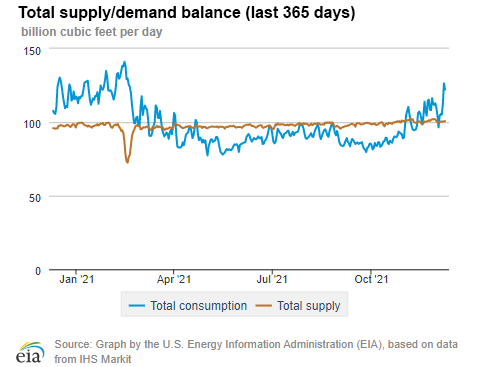
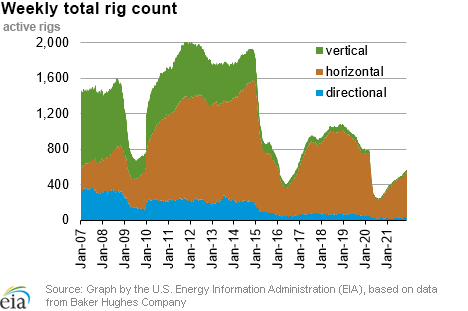
| Rigs | |||
|---|---|---|---|
Tue, November 30, 2021 |
Change from |
||
last week |
last year |
||
| Oil rigs | 467 |
0.0% |
89.8% |
| Natural gas rigs | 102 |
0.0% |
36.0% |
| Note: Excludes any miscellaneous rigs | |||
| Rig numbers by type | |||
|---|---|---|---|
Tue, November 30, 2021 |
Change from |
||
last week |
last year |
||
| Vertical | 25 |
13.6% |
56.3% |
| Horizontal | 513 |
0.0% |
77.5% |
| Directional | 31 |
-8.8% |
72.2% |
| Source: Chart by the U.S. Energy Information Administration (EIA), based on data from Baker Hughes Company | |||
| Working gas in underground storage | ||||
|---|---|---|---|---|
Stocks billion cubic feet (Bcf) |
||||
| Region | 2021-12-03 |
2021-11-26 |
change |
|
| East | 843 |
867 |
-24 |
|
| Midwest | 1,019 |
1,043 |
-24 |
|
| Mountain | 206 |
206 |
0 |
|
| Pacific | 266 |
263 |
3 |
|
| South Central | 1,171 |
1,185 |
-14 |
|
| Total | 3,505 |
3,564 |
-59 |
|
|
Source: U.S. Energy Information Administration Form EIA-912, Weekly Underground Natural Gas Storage Report | ||||
| Working gas in underground storage | |||||
|---|---|---|---|---|---|
Historical comparisons |
|||||
Year ago (12/3/20) |
5-year average (2016-2020) |
||||
| Region | Stocks (Bcf) |
% change |
Stocks (Bcf) |
% change |
|
| East | 918 |
-8.2 |
859 |
-1.9 |
|
| Midwest | 1,099 |
-7.3 |
1,036 |
-1.6 |
|
| Mountain | 233 |
-11.6 |
213 |
-3.3 |
|
| Pacific | 313 |
-15.0 |
294 |
-9.5 |
|
| South Central | 1,299 |
-9.9 |
1,192 |
-1.8 |
|
| Total | 3,861 |
-9.2 |
3,595 |
-2.5 |
|
| Source: U.S. Energy Information Administration Form EIA-912, Weekly Underground Natural Gas Storage Report | |||||
| Temperature – heating & cooling degree days (week ending Dec 02) | ||||||||
|---|---|---|---|---|---|---|---|---|
HDDs |
CDDs |
|||||||
| Region | Current total |
Deviation from normal |
Deviation from last year |
Current total |
Deviation from normal |
Deviation from last year |
||
| New England | 210 |
14 |
73 |
0 |
0 |
0 |
||
| Middle Atlantic | 191 |
4 |
65 |
0 |
0 |
0 |
||
| E N Central | 207 |
-8 |
24 |
0 |
0 |
0 |
||
| W N Central | 168 |
-73 |
-41 |
0 |
0 |
0 |
||
| South Atlantic | 136 |
7 |
45 |
4 |
-6 |
-10 |
||
| E S Central | 138 |
5 |
17 |
0 |
-1 |
0 |
||
| W S Central | 74 |
-23 |
-15 |
3 |
-1 |
-2 |
||
| Mountain | 130 |
-75 |
-75 |
1 |
1 |
1 |
||
| Pacific | 48 |
-59 |
-51 |
0 |
-1 |
0 |
||
| United States | 144 |
-24 |
4 |
1 |
-1 |
-2 |
||
|
Source: Chart by the U.S. Energy Information Administration (EIA), based on data from the National Oceanic and Atmospheric Administration Note: HDDs=heating degree days; CDDs=cooling degree days | ||||||||
Deviation between average and normal (°F)
7-day mean ending Dec 02, 2021
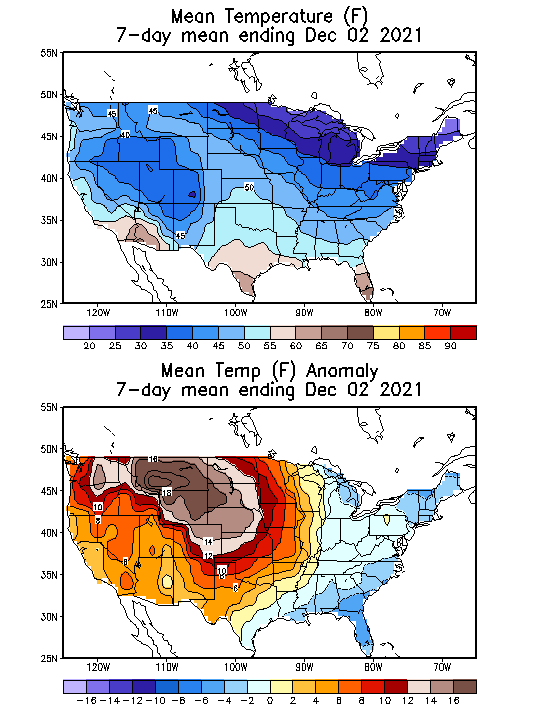
Source: National Oceanic and Atmospheric Administration

